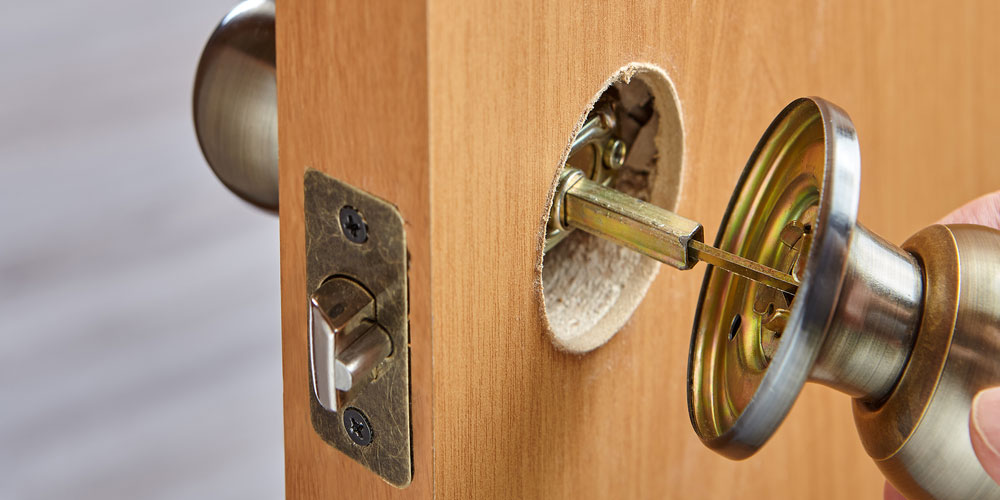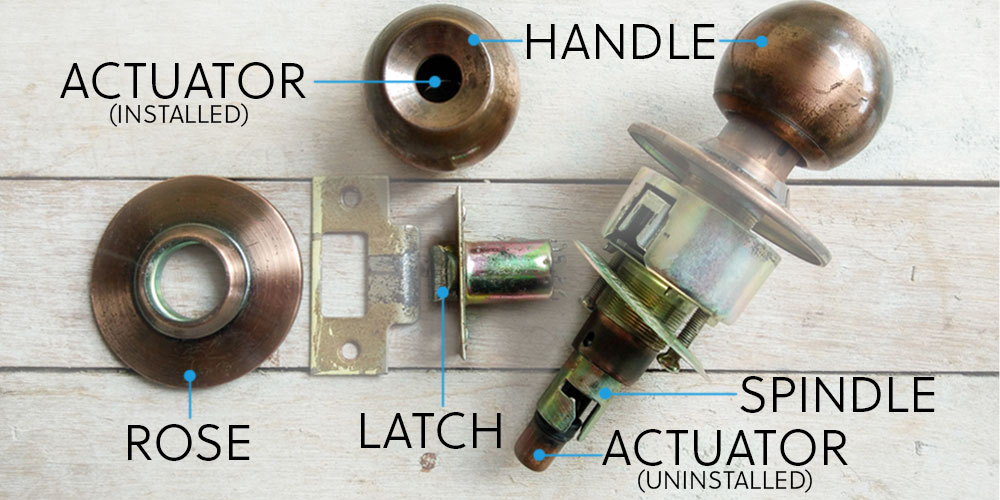Lock Blog
A resource for consumers, locksmiths, and security professionals
A resource for consumers, locksmiths, and security professionals

Are you ready to start replacing interior door knobs? While you are getting yourself prepared for this task, it is important to hold off until you have done the required due diligence. You may not need to replace your locks, or it may violate your lease. Do not jump into replacing interior door knobs without taking the flowing into consideration.
Replacing interior door knobs is usually very simple and straightforward. But things will become more complicated if the door will not open or you cannot find the method to disassemble your existing interior door lock. Common difficulties are removing broken locks, opening stuck doors, and finding hidden screws during disassembly.
The average time elapsed for replacing interior door knobs is 10 minutes for a professional locksmith (5 min for disassembly + 5 min for installation). If you are performing the work yourself, expect to spend at least double that amount of time. When there are any complications such as difficult removal or nonstandard disassembly, procedures expect to spend at least 30 minutes without professional assistance.
Replacing a door knob will require at least one Phillips-head screwdriver. For faster replacement, you can use a Phillips-head bit on a power drill. If your door knob has hidden screws, you may need a catch release tool to remove the knob and rose before you can access the screws. Changing locks also requires instructions specific to your locks in terms of disassembly and reassembly.
A door knob without screws is either secured with a threaded rose, or the rose is hiding the screws. A threaded rose can be turned to the left and the handle, and you can finish replacing your interior door knob. If you are dealing with hidden screws, find the knob release. Then remove the knob and rose to expose the screws. The knob release will likely be a hole that is visible when it is turned. Insert a tool that fits the release hole until a ‘click’ signals the release.

The various components of interior door knob hardware are referred to by a variety of names and can be broken down into many sub-parts. For the sake of clarity and simplicity, we are going to limit the names and parts mentioned. Understanding the rest of the information about replacing interior door knobs requires us to be on the same page about the hardware parts.
Handle – The handle rotates and manipulates the spindle to retract the latch. Locking occurs when the knob is not free to rotate or rotates without affecting the latch. Because the complete set of hardware is referred to as a door knob, we will refer to this part as a handle to reduce confusion.
Rose – Between the door and handle, you will find a piece of metal that covers the hole the interior and exterior handles are connected through. On interior non-keyed door knobs, the rose may twist off to allow for the device to be removed. If the rose is not threaded, the interior side of a rose will have accessible set screws. Screws may be hidden underneath the rose.
Spindle – The spindle connects both the interior and exterior handles through the door. The spindle will rotate to move the latch assembly and retract the latch. When the interior door knob is in the locked position, the handle will not turn the spindle to retract the latch.
Latch – The latch extends into the door frame keeping the door from freely opening without handle rotation. The latch is part of a latch assembly, which interacts with the spindle. The latch is spring-loaded, extending out until the spring is contracted by the spindle’s rotation.
Actuator – If the door locks, it will have a lock actuator that keeps the door knob from retracting the latch. On interior door knobs, this will be a push button or thumbturn. When the lock is installed, the actuator will be found on the interior handle.
Do not begin replacing interior door knobs until you have done the appropriate level of pre-planning. Make sure you are allowed to change your locks. In some cases, replacing interior door handles is not going to fix the issue you are experiencing. It is also important to plan for any desired upgrades and not sacrifice your current level of safety.
If you are changing locks in your apartment, you should check with your property manager. This is especially true if you are adding keyed interior locks, which may restrict their access to the property during maintenance. In most cases, you will have no issue replacing interior door knobs, but it could still benefit you in terms of passing on the replacement costs.
Certain clauses in a lease make property owners responsible for improving apartment security if there is damage to a lock. This may apply to replacing an interior door lock in a space with multiple tenants. And if you do not inform your landlord, they will not be able to request a spare key. So in the event, you are essentially locked out of your apartment because of an interior door lock, your landlord cannot easily assist you.
If you are replacing interior door knobs to solve an issue with a broken lock, you may find that the problem is not with the lock. For example, if you have a stuck door latch, it could be due to the door expanding or warping. Your foundation may also be causing the door to stick, which cannot be solved by replacing interior door handles.
When a door knob turns but won’t open, check to see if the latch is retracting. If the latch pulls free from the door frame and the door still has trouble opening, then the door is wedging regardless of the lock. A latch that will not line up with the strike plate will keep the door from closing properly, but that must be addressed before replacing interior door knobs.
Sometimes replacing interior door handles is done to add a lock to a previously unsecured door. You can also change out existing locks with keyed alike door locks to update your physical access control. Just be sure you are not relying on a keyed interior door knob as the sole means of security for a given door.
The spring-loaded latch this type of interior door lock uses is extremely easy to bypass. This lower security is helpful if you are locked out of your bedroom, but it does not offer you much protection for theft or unauthorized entry. If you are concerned about criminal lock picking, replacing interior door knobs is not the solution you are looking for.
Interior door locks are intended for privacy, which diminishes security for safety. For example, the security of bathroom door locks is much less important than being able to open the door in the event of a fall or injury. When you are replacing interior door knobs, it is a good idea to look into how you plan to bypass them in the event of an emergency.
Find a way to unlock your bathroom door before installing it, so you do not need to resort to breaking the door down in an emergency. If you are kicking down an interior door, you can potentially harm whoever is behind the door or harm yourself. Consider the safety of your interior lock in terms of how you can open it when someone needs assistance.
Before replacing interior door knobs, make sure to have your new hardware in hand. If you are changing the aesthetic of your interior locks, you want to make sure that you are purchasing all of your new interior locks at the same time. It is very common for people to buy their new locks piecemeal, then end up not being able to make their interior door locks visually match.
Whether it is the wrong shade of colored brass, styling differences, or different lock functionality, it can be frustrating to start replacing interior door knobs and then end up with a patchwork of different products. Besides aesthetics, miss-matched interior door locks can also lead to home lockouts. For example, a lock that can turn from the inside even when locked can lead people to close the door behind not knowing they cannot re-enter without a key.
To reduce the cost of changing locks, you may wish to go about replacing interior door knobs yourself. In most cases, this is one of the simplest DIY home security upgrades, but it can get tricky depending on your situation. If you are uncertain about whether you have a door issue or a lock malfunction, it will be beneficial to call a locksmith.
Most people see locksmith prices as the cost of service, but you are paying for experience. A locksmith can guide you through your options and give you deeper insight into the best options for replacing interior door knobs. Perhaps your situation can be solved by rekeying instead of replacing locks. Without a locksmith, you may never know.
Whether you are changing locks on your new home or updating problematic door handles, check that you are within your rights to make lock changes and that those changes will fix your issue. Once you are sure lock installation is the correct course of action, be sure that your new interior door knobs are balancing security and safety. Finally, choose the proper hardware before moving forward, and determine who will handle the installation.
Category: Commercial, Residential, Safety & Security